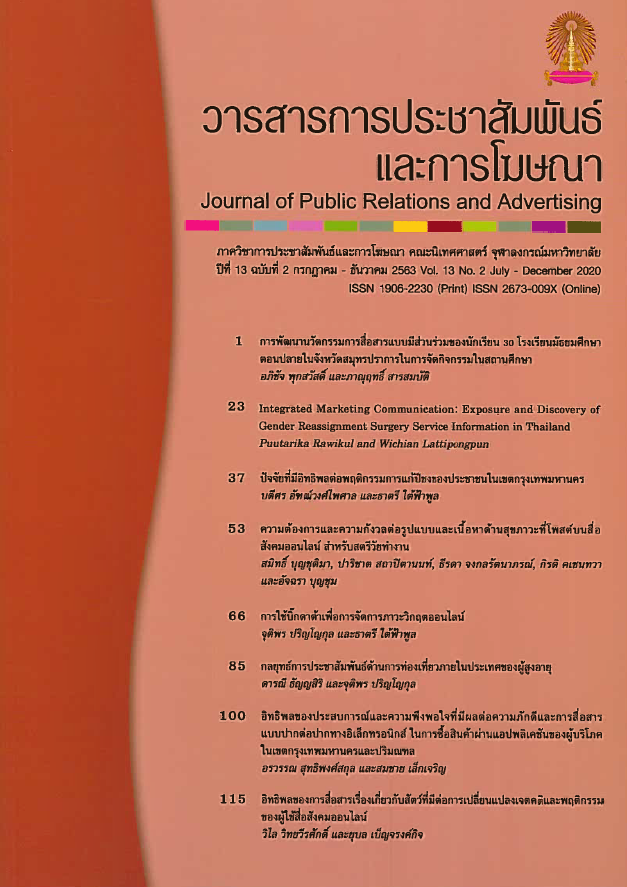อิทธิพลของการสื่อสารเรื่องเกี่ยวกับสัตว์ที่มีต่อการเปลี่ยนแปลงเจตคติและพฤติกรรมของผู้ใช้สื่อสังคมออนไลน์
Main Article Content
บทคัดย่อ
งานวิจัยนี้มีวัตถุประสงค์เพื่อศึกษาหัวข้อดังต่อไปนี้ 1) การเรียนรู้จากการเปิดรับสื่อสังคมออนไลน์ที่มีเนื้อหาเกี่ยวกับสัตว์ของกลุ่มผู้รับสาร 2) การเปลี่ยนเจตคติของผู้รับสารจากการเปิดรับสื่อสังคมออนไลน์ที่มีเนื้อหาเกี่ยวกับสัตว์ 3) การเกิดสังคมเครือข่ายจากการสื่อสารเรื่องเกี่ยวกับสัตว์ในสื่อสังคมออนไลน์ 4) กิจกรรมเกี่ยวกับสัตว์ที่เกิดจากการสื่อสารของสังคมเครือข่าย โดยงานวิจัยครั้งนี้เริ่มด้วยการวิจัยเชิงคุณภาพเป็นการสัมภาษณ์เชิงลึก (In-depth Interview) กลุ่มตัวอย่าง 15 ท่าน ชาย 6 คนและหญิง 9 คน ซึ่งทุกท่านล้วนเป็นผู้ที่ได้รับการยอมรับว่ามีบทบาทในการดูแล คุ้มครองสวัสดิภาพสัตว์อย่างกว้างขวาง ตามด้วยการวิจัยเชิงปริมาณโดยการตอบแบบสอบถามทางออนไลน์ (Online Questionnaire) โดยกลุ่มตัวอย่างเป็นคนรักสัตว์ 420 คน ผลที่ได้ทั้งจากการวิจัยสามารถสรุปได้ดังนี้ 1) สื่อที่กลุ่มคนรักสัตว์ดูหรือสื่อสารเรื่องสัตว์มากที่สุดคือสื่อเฟซบุ๊ก โดยส่วนใหญ่มีความถี่ในการใช้ตลอดทั้งวันสูงถึง 87.62% และดูผ่านโทรศัพท์มือถือมากที่สุด โดยสื่อดั้งเดิมคือโทรทัศน์และหนังสือพิมพ์ยังคงมีความสำคัญ มีบทบาทช่วยกระตุ้นให้กระแสเรื่องเกี่ยวกับสัตว์กระเพื่อมแรงขึ้นเกิดเป็นกระแสสังคม 2) จากผลวิจัยที่วิเคราะห์ด้วยการวิเคราะห์เส้นทาง (Path Analysis) ด้วยโปรแกรมเอ็ม-พลัส (M-Plus) สรุปได้ว่าการสื่อสารเรื่องเกี่ยวกับสัตว์ทางสื่อสังคมออนไลน์มีโครงสร้างความสัมพันธ์ของตัวแปรเป็นเส้นตรง โดยต้องผ่านตัวแปรส่งผ่าน (Mediator) เรียงลำดับโดยผ่านสื่อ (Media) ก่อให้เกิดการเรียนรู้ (Learning) มากมายโดยเฉพาะเรื่องคุณค่าของชีวิต ทำให้ผู้ดูสื่อเกิดการเปลี่ยนเจตคติ (Attitude) รักสัตว์มากขึ้น และผลักดันให้เกิดพฤติกรรม มีการรวมกลุ่มเป็นสังคมเครือข่ายคนรักสัตว์ (Network Society) ที่ใหญ่ขึ้นอย่างรวดเร็ว และมีการทำกิจกรรมเกี่ยวกับสัตว์ร่วมกัน (Activity) โดยเฉพาะกิจกรรมการช่วยเหลือสัตว์ และกิจกรรมที่ทำให้เกิดการเปลี่ยนแปลงในสังคมในวงกว้างที่เรียกว่าการเคลื่อนไหวทางสังคม (Social Movement) เช่น การเรียกร้องให้ออกกฎหมายเพื่อคุ้มครองสัตว์ กล่าวโดยสรุปการสื่อสารเรื่องเกี่ยวกับสัตว์ในสื่อสังคมออนไลน์ทำให้เกิดการเปลี่ยนแปลงทั้งในระดับปัจเจกบุคคลและสังคมในวงกว้างโดยมีสื่อสังคมออนไลน์เป็นช่องทางการสื่อสารหลัก และมีสื่อดั้งเดิมคือโทรทัศน์และหนังสือพิมพ์ช่วยกระตุ้นให้เกิดกระแสในวงกว้างมากขึ้น ร่วมด้วยการปลูกฝังผ่านครอบครัว โรงเรียนและสังคมแวดล้อม
Article Details
เอกสารอ้างอิง
กาญจนา แก้วเทพ และสมสุข หินวิมาน. (2551). สายธารแห่งนักคิดทฤษฎีเศรษฐศาสตร์การเมืองกับสื่อสารการศึกษา. กรุงเทพมหานคร: ภาพพิมพ์.
ช่อง 3. (2554, 30 มิถุนายน). รายการไอที24ชั่วโมง iT 24Hrs[รายการโทรทัศน์] กรุงเทพมหานคร: อ.ส.ม.ท. วันที่เข้าถึงข้อมูล14 กันยายน 2562, แหล่งที่มา http://www.it24hrs.com/2011/help-animal-find-home-with-it/
ไชยรัตน์ เจริญสินโอฬาร. (2540). ขบวนการเคลื่อนไหวทางสังคมรูปแบบใหม่/ขบวนการเคลื่อนไหวประชาสังคมในต่างประเทศ. กรุงเทพมหานคร: ศูนย์วิจัยและผลิตตำรา มหาวิทยาลัยเกริก.
ธีระพร อุวรรณโณ. (2535). เจตคติ การศึกษาตามแนวทฤษฎีหลัก. กรุงเทพมหานคร: จุฬาลงกรณ์มหาวิทยาลัย.
แพนด้าOK. (2557, 31 กรกฎาคม).บทสัมภาษณ์ โก๋เอ็ม บุดด้า เบลส ฮิปฮอปหัวใจหล่อกับการช่วยเหลือหมาไร้บ้าน วันที่เข้าถึงข้อมูล 14 กันยายน 2562, แหล่งที่มา http://www.dogilike.com/content/tip/3555/
สุรพงศ์ โสธนะเสถียร. (2533). Selective Exposure theory. วันที่เข้าถึงข้อมูล 14 กันยายน 2562, แหล่งที่มา http://thesis.swu.ac.th/swuthesis/Man/Subanphot_R.pdf
อัศวิน เนตรโพธิ์แก้ว. (2555). การสื่อสารผ่านสื่อใหม่ในยุคสังคมสารสนเทศ. วารสารอิศราปริทัศน์, 1(2), 80-90.
A CAT Reseller. (2558, 28 ธันวาคม). ที่ 1 ในใจ เก๋ ชลลดา ช่วยต่อชีวิตผ่านโลกโซเชียล [ไฟล์วีดีโอ] กรุงเทพมหานคร: True move H. วันที่เข้าถึงข้อมูล 14 กันยายน 2562, แหล่งที่มา https://www.youtube.com/watch?v=xFKAcWicB3Q&hd=1
Alberto, M. (1989). Social movement theory. In J. Keane & P. Mier (Eds.), Nomads of the present: Social movements and individual needs in contemporary society. London: Hutchinson Radius.
Allport, G. W. (1935). Attitudes. In C. Murchison (Ed.), Handbook of social psychology. Worcester, MA: Clark University Press.
Bandura, A. (1986). Social foundations of thought and action: A social cognitive theory. New York, NJ: Prentice-Hall.
Bandura, A. (2013, August 30). Bandura and social learning theory [Video file]. Retrieved 13 September, 2019, from https://www.youtube.com/watch?v=NjTxQy_U3ac
Blumer, H. (1969). Collective behavior. In A. M. Lee (Ed.), Principles of sociology (pp. 165-221). New York, NY: Barnes and Noble.
Cacioppo, J. T., & Petty, R. E. (1989). Effects of message repetition, on argument processing, recall and persuasion. Basic and Applied Social Psychology, 10(1), 3-12.
Castells, M. (2009). Communication power. New York: Oxford University Press.
Friedman, T. L. (2005). The world is flat: A brief history of the twenty-first century. New York: Farrar, Straus and Giroux.
Katz, E. (1959). Mass communications research and the study of popular culture: An editorial note on a possible future for this journal. Studies in Public Communication, 2, 1-6.
Katz, E., Gurevitch, M., & Hass, H. (1973). On the use of the mass media for important things. American Sociological Review, 38(2), 164-181.
Kingdom of Tigers. (2013). Timeline [Facebook page]. Retrieved September 14, 2019, from https://www.
facebook.com/kingdomoftigers/ (In Thai)
Kingdom of Tigers. (2014). Timeline [Facebook page]. Retrieved September 14, 2019, from https://www.facebook.com/kingdomoftigers/?fref=ts (In Thai)
Klapper, J. T. (1960). The effect of mass communication. New York: The Free Press.
McLuhan, M. (1964). Understanding media: The extensions of man. New York: McGraw-Hill.
Nielsen. (2015). Global trust in advertising. Retrieved September 14, 2019, from https://www.nielsen.com/us/en/insights/report/2015/global-trust-in-advertising-2015/
Rogers, C. R. (1978). Carl Rogers on personal power: Inner strength and its revolutionary impact. London: Constable.
Schramm, W. (1973). Channels and audience. In Handbook of communication. Chicago: Ran McNally College Publishing Company.


